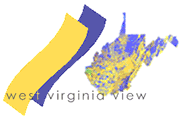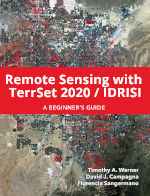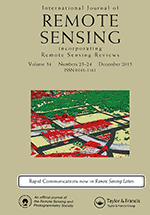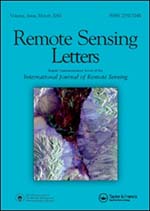My Remote Sensing Students at WVU G&G

PhD (GEOGRAPHY)
Object-based supervised machine learning regional scale land-cover classification using high resolution remotely sensed data, Christopher Ramezan, 2019
Towards quantifying the effects of resource extraction on land cover and topography through remote sensing analysis: confronting issues of scale and data scarcity, Jessica DeWitt, 2016
Reclaimed surface mine terrestrial pools: Integrating remote sensing, spatial data and field work. Sheila Kazar, 2011
An Investigation of The Role of Image Properties in Influencing the Accuracy of Remote Sensing Change Detection Analysis. Abdullah Almutairi, 2004
Integrating Spatial and Spectral Information for Automatic Feature Identification in High Spatial Resolution Remotely Sensed Images. Jong Yeol Lee, 2000
PhD (GEOLOGY)
Remote Sensing for Monitoring the Mountaintop Mining Landscape: Applications for Land Cover Mapping at the Individual Mine Complex Scale. Aaron Maxwell, 2015.
Integrating visible, near infrared and short wave infrared hyperspectral and multispectral thermal imagery for geological mapping at Cuprite, Nevada. Xianfeng Chen, 2005
MS (GEOLOGY) (Thesis Option)
Mapping Surficial Geology in the New River Gorge National River and Bluestone National Scenic River, West Virginia, using LiDAR-derived Digital Elevation Data, Marla Denicola, 2020. (Co-advised with Dr. J. Steven Kite)
Multiple Data Set Integration and GIS Techniques Used to Investigate Linear Structural Controls in the Southern Powder River Basin, Wyoming. Heath Rasco, 1999.
MS (GEOLOGY) (Professional Studies Option)
Using LiDAR and GIS Tools to Determine Land Stability in the Appalachians: A case study in Gilmer County, West Virginia, Jessica Gormont, 2007.
Evaluation of the use of hyperspectral imagery for identification of microseeps near Santa Barbara, California. Heather Freeman, 2003. (3 MB pdf)
A Pilot Study: Using knowledge-based classification to identify springs in a portion of the Sewickley Creek Basin, Pennsylvania. Dana Jennings, 2002. (7 MB pdf)
M.A. (GEOGRAPHY) (Thesis Option)
Using lidar to approximate keystone structure and evaluate management practices in potential habitats of the endangered Karner blue butterfly (Lycaeides melissa samuelis), Brandyn Balch, 2019.
Evaluation of the potential for detection and classification of Ailanthus altissima (tree of heaven) using lidar data, Cassidy Rhea, 2012.
Forest fragmentation mapping, change detection, and gas well site identification in remotely sensed imagery: the role of spatial resolution, Ben Baker, 2012.
Exploring the utility of a GIScience approach to modeling invasive species: A case study of Ailanthus altissima , Arthur Elmes, 2010
Seasonal trends in separability of leaf reflectance spectra for Ailanthus altissima and four other tree species, Aaron Burkholder, 2010. (See also Burkholder, A., T.A. Warner, M. Culp and R.E. Landenberger. 2011. Seasonal trends in separability of leaf reflectance spectra for Ailanthus altissima and four other tree species. Photogrammetric Engineering & Remote Sensing 77(8): 793-804.
Remote Sensing Of Corridor Landscapes: A Case Study of the National Road, Wheeling, West Virginia. Brian Renzella, 2005.
The History of Presque Isle and the City of Erie, Pennsylvania: A Remote Sensing Case Study. Christopher Schaney, 2003.
Monitoring Land-Cover Change Detection in an Arid Urban Environment: Comparison of Change detection Techniques. Abdullah Almutairi, 2000.
An Evaluation of AVHRR NDVI Data for Monitoring Western Spruce Budworm Defoliation. Zainal Abdul Majeed, 1999.
Identifying Structural Differences in Mixed Mesophytic and Northern Hardwood Forests on the Monongahela National Forest Using Remote Sensing Data. John Bender, 1999.
Automatic Selection of Optimal Window Size and Shape for Texture Analysis. Joe Glotfelty, 1999.
Scale and Texture in Digital Image Classification. Chris Ferro, 1998. (See also: Ferro, C. J. and T. A. Warner, 2002. Scale and texture in digital image classification. Photogrammetric Engineering and Remote Sensing 68 (1): 51-63.)
Evaluation of the relative value of spectral and phenological information for tree crown classification of digital images, Thomas Key, 1998. (See also: Key, T., T. Warner, J. McGraw, and M. A. Fajvan, 2001. A comparison of multispectral and multitemporal imagery for tree species classification. Remote Sensing of Environment 75: 100-112.
Potential of Remote Sensing and Geographical Information Systems to Evaluate Mine Areas. Doug Brown, 1996.
An Investigation of the Economic Aspects of Environmental Regulation of the Surface Coal Mining Industry in Central Appalachia. Roger Cottrell, 1996.
An Examination of Abandoned Hazardous Waste, Class and Race in West Virginia. Jessica Biggers, 1996.
Addressing Categorical Uncertainty in Image Classification. Mike Shank, 1995.
M.A. (GEOGRAPHY) (Professional Studies Option)
Remote sensing of forest types in the Great Dismal Swamp National Wildlife Refuge using object-based methods, Ben Sawyer, 2013.
Evaluating the potential of remote Sensing to detect the rate of landscape change: A Monongalia County Case Study, Jacob Drvar, 2007.
Standard operating procedure for primary remote sensing data acquisition, Sandra Frank, 2006.
Unmixing Hyperion imagery for fuzzy classification of sagebrush, juniper, shale and sandstone, Jeremy Tensen, 2007.
Lidar-derived forest metrics and bird species occurrence: A case study from the Core Arboretum, Morgantown, WV. Eric Hopkins, 2006.
A Comparison of Four Change Detection Techniques for Two Urban Areas in the United States, James Anderson, 2002.
A of digital photogrammetric and LIDAR high resolution digital elevation models, Jian Zhang, 2002.
The Fernow Experimental Forest: An Analysis of Historical Change. Jennifer McCullough, 1999.


 Free satellite imagery, lidar data, and other imagery
Free satellite imagery, lidar data, and other imagery




